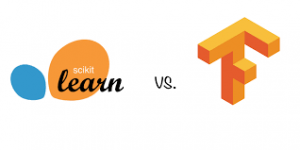
In this post, you will learn about when to use Scikit-learn vs Tensorflow. For data scientists/machine learning enthusiasts, it is very important to understand the difference such that they could use these libraries appropriately while working on different business use cases.
When to use Scikit-learn?
Scikit-learn is a great entry point for beginners data scientists. It provides an efficient implementation of many machine learning algorithms. In addition, it is very simple and easy to use. You can get started with Scikit-learn in a very easy manner by using Jupyter notebook. Scikit-learn can be used to solve different kinds of machine learning problems including some of the following:
- Classification (SVM, nearest neighbors, random forest, logistic regression, etc)
- Regression (SVR, nearest neighbors, random forest, etc)
- Clustering (K-means, spectral clustering, etc)
- Model selection (grid search, cross-validation, metrics etc)
- Dimensionality reduction (K-means, feature selection, etc)
Scikit-learn mainly works with tabular data.
When to use Tensorflow?
Tensorflow, on the other hand, makes it possible to train and run very large neural networks efficiently based on deep learning algorithms by distributing the computations across potentially thousands of multi-GPU servers. It is a more complex library for distributed numerical computation using data flow graphs. Simply speaking, Tensorflow is a low-level library that is used for deep learning models, unlike scikit-learn which can be considered as the high-level library used to train classical machine learning models.
Tensorflow works with a variety of data such as tabular, text, images, audio, and video.
- Coefficient of Variation in Regression Modelling: Example - November 9, 2025
- Chunking Strategies for RAG with Examples - November 2, 2025
- RAG Pipeline: 6 Steps for Creating Naive RAG App - November 1, 2025
I found it very helpful. However the differences are not too understandable for me